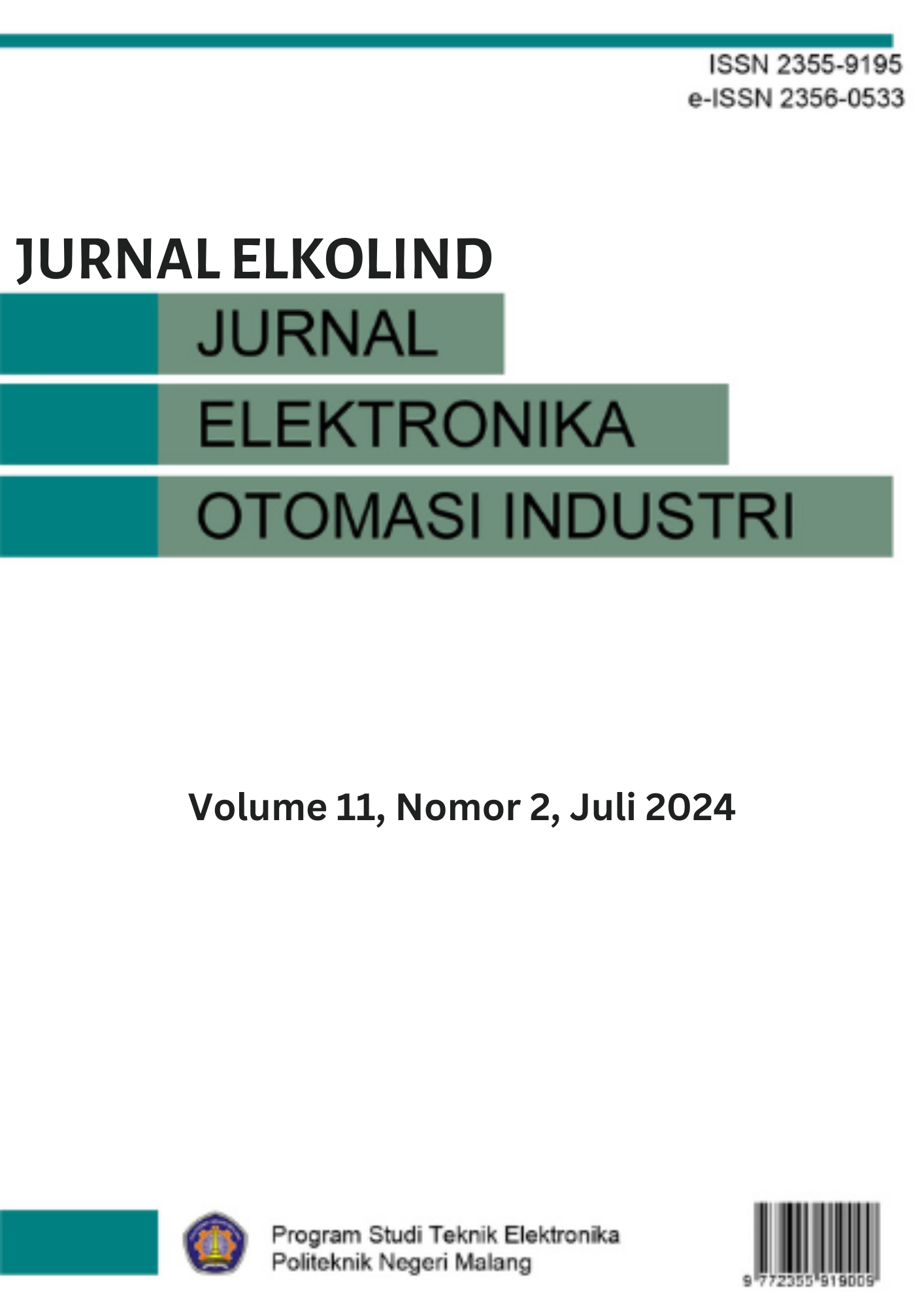Main Article Content
Abstract
Along with the expansion of Indonesian waters, maritime technology and robotics have grown significantly, making it an attractive field of technology. Autonomous Underwater Vehicle (AUV) is an autonomous underwater robot that can operate and maneuver independently based on given commands. AUVs are used in a variety of applications such as environmental monitoring, underwater infrastructure maintenance, and scientific research. To optimize AUV movement, this research develops and applies kinematics with six degrees of freedom (6-DOF) movement, namely surge, heave, sway, pitch, roll and yaw. The focus of this research is on the HYDROShips robot from the PPNS robotics team which uses 7 thruster motors to control movement in two types of kinematics: horizontal and vertical. A geometric approach is used to integrate translational and rotational movements, simplify the input given to the robot, and maximize the output on each motor. The research results show that this approach improves the efficiency and stability of the HYDROShips robot's movements, enabling the navigation of complex underwater routes with high precision. This research is expected to make a significant contribution to the development of autonomous underwater robots and improve the operational efficiency and effectiveness of AUVs in various applications.
Keywords
Article Details
Copyright (c) 2024 Muhammad Indrastata Iftitana Arvi, Joko Endrasmono, Dimas Pristovani Riananda, Isa Rachman, Noorman Rinanto, Adianto

This work is licensed under a Creative Commons Attribution 4.0 International License.
References
- S. Sholehudin, “Inovasi Terbaru Dalam Robotika: Tantangan Dan Peluang Di Era Digital,” vol. 2, no. 4, 2022.
- M. M. Nawirma and S. G. Zain, “Pengembangan Sistem Monitoring Pada Robot Underwater Dengan Menggunakan Kamera Webcam,” J. Embed. Syst. Secur. Intel. Syst., vol. 01, no. November, pp. 88–96, 2020.
- C. Pramuliasari, “MODEL KINEMATIS BALLAST PADA GERAK AUTONOMOUS UNDERWATER VEHICLE (AUV),” 2019.
- E. Darmawan Yudi and J. A. Yani No, “Literature Review : Implementasi Sistem Monitoring Robot Bawah Air (Underwater Robot) berbasis IoT menggunakan metode Fuzzy Logic,” J. Ilmu Data dan Kecerdasan Buatan, vol. 1, no. 1, pp. 5–8, 2023.
- T. Herlambang, H. Nurhadi, and E. B. Djatmiko, “Optimasi Model Linier 6-DOF pada Sistem Autonomous Underwater Vehicle,” Semin. MASTER PPNS, vol. 01, no. 01, pp. 69–74, 2016.
- M. A. Garcia-Murillo, R. E. Sanchez-Alonso, and J. Gallardo-Alvarado, “Kinematics and dynamics of a translational parallel robot based on planar mechanisms,” Machines, vol. 4, no. 4, pp. 1–14, 2016.
- B. Utomo and Munandi, “Analisa Forward Dan Inverse Kinematics Pada Simulator Arm Robot 5 Derajat Kebebasan,” J. Tek. Mesin, vol. 1, no. 3, pp. 11–20, 2013.
- K. Oktafianto, T. Herlambang, Mardlijah, and H. Nurhadi, “Design of Autonomous Underwater Vehicle motion control using Sliding Mode Control method,” ICAMIMIA 2015 - Int. Conf. Adv. Mechatronics, Intell. Manuf. Ind. Autom. Proceeding - conjunction with Ind. Mechatronics Autom. Exhib. IMAE, vol. 2015, no. Icamimia, pp. 162–166, 2016.
- O. Hassanein, S. A. Salman, S. G. Anavatti, and T. Ray, “ANFN controller based on differential evolution for Autonomous Underwater Vehicles,” Proc. 2012 1st Int. Conf. Innov. Eng. Syst. ICIES 2012, no. December, pp. 184–189, 2012.
- H. Yang and F. Zhang, “Geometric formation control for autonomous underwater vehicles,” Proc. - IEEE Int. Conf. Robot. Autom., pp. 4288–4293, 2010.
- I. D. Nugraha, “Pendekatan Geometri untuk Perhitungan Inverse Kinematics Gerakan Lengan Robot 4 Derajat Kebebasan,” J. Tek. Mesin ITI, vol. 5, no. 1, p. 1, 2021.
- E. Dan, P. Sistem, and K. Robust, “06111750012014_Master_Thesis,” 2020.
References
S. Sholehudin, “Inovasi Terbaru Dalam Robotika: Tantangan Dan Peluang Di Era Digital,” vol. 2, no. 4, 2022.
M. M. Nawirma and S. G. Zain, “Pengembangan Sistem Monitoring Pada Robot Underwater Dengan Menggunakan Kamera Webcam,” J. Embed. Syst. Secur. Intel. Syst., vol. 01, no. November, pp. 88–96, 2020.
C. Pramuliasari, “MODEL KINEMATIS BALLAST PADA GERAK AUTONOMOUS UNDERWATER VEHICLE (AUV),” 2019.
E. Darmawan Yudi and J. A. Yani No, “Literature Review : Implementasi Sistem Monitoring Robot Bawah Air (Underwater Robot) berbasis IoT menggunakan metode Fuzzy Logic,” J. Ilmu Data dan Kecerdasan Buatan, vol. 1, no. 1, pp. 5–8, 2023.
T. Herlambang, H. Nurhadi, and E. B. Djatmiko, “Optimasi Model Linier 6-DOF pada Sistem Autonomous Underwater Vehicle,” Semin. MASTER PPNS, vol. 01, no. 01, pp. 69–74, 2016.
M. A. Garcia-Murillo, R. E. Sanchez-Alonso, and J. Gallardo-Alvarado, “Kinematics and dynamics of a translational parallel robot based on planar mechanisms,” Machines, vol. 4, no. 4, pp. 1–14, 2016.
B. Utomo and Munandi, “Analisa Forward Dan Inverse Kinematics Pada Simulator Arm Robot 5 Derajat Kebebasan,” J. Tek. Mesin, vol. 1, no. 3, pp. 11–20, 2013.
K. Oktafianto, T. Herlambang, Mardlijah, and H. Nurhadi, “Design of Autonomous Underwater Vehicle motion control using Sliding Mode Control method,” ICAMIMIA 2015 - Int. Conf. Adv. Mechatronics, Intell. Manuf. Ind. Autom. Proceeding - conjunction with Ind. Mechatronics Autom. Exhib. IMAE, vol. 2015, no. Icamimia, pp. 162–166, 2016.
O. Hassanein, S. A. Salman, S. G. Anavatti, and T. Ray, “ANFN controller based on differential evolution for Autonomous Underwater Vehicles,” Proc. 2012 1st Int. Conf. Innov. Eng. Syst. ICIES 2012, no. December, pp. 184–189, 2012.
H. Yang and F. Zhang, “Geometric formation control for autonomous underwater vehicles,” Proc. - IEEE Int. Conf. Robot. Autom., pp. 4288–4293, 2010.
I. D. Nugraha, “Pendekatan Geometri untuk Perhitungan Inverse Kinematics Gerakan Lengan Robot 4 Derajat Kebebasan,” J. Tek. Mesin ITI, vol. 5, no. 1, p. 1, 2021.
E. Dan, P. Sistem, and K. Robust, “06111750012014_Master_Thesis,” 2020.
